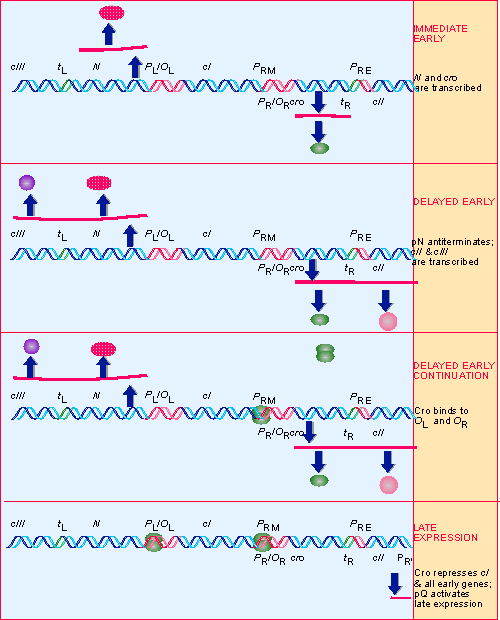10. A delicate balance: lysogeny versus lysis
11.10 A delicate balance: lysogeny versus lysis |
 |
Figure 11.26 A cascade is needed to establish lysogeny, but then this circuit is switched off and replaced by the autogenous repressor-maintenance circuit. |
 |
Figure 11.27 The lytic cascade requires Cro protein, which directly prevents repressor maintenance via PRM, as well as turning off delayed early gene expression, indirectly preventing repressor establishment |
The programs for the lysogenic and lytic pathways are so intimately related that it is impossible to predict the fate of an individual phage genome when it enters a new host bacterium. Will the antagonism between repressor and Cro be resolved by establishing the autogenous maintenance circuit shown in Figure 11.26, or by turning off repressor synthesis and entering the late stage of development shown in Figure 11.27?
The same pathway is followed in both cases right up to the brink of decision. Both involve the expression of the immediate early genes and extension into the delayed early genes. The difference between them comes down to the question of whether repressor or Cro will obtain occupancy of the two operators.
The early phase during which the decision is taken is limited in duration in either case. No matter which pathway the phage follows, expression of all early genes will be prevented as PL and PR are repressed; and, as a consequence of the disappearance of CII and CIII, production of repressor via PRE will cease.
The critical question comes down to whether the cessation of transcription from PRE is followed by activation of PRM and the establishment of lysogeny, or whether PRM fails to become active and the pQ regulator commits the phage to lytic development.
The initial event in establishing lysogeny is the binding of repressor at OL1 and OR1. Binding at the first sites is rapidly succeeded by cooperative binding of further repressor dimers at OL2 and OR2. This shuts off the synthesis of Cro and starts up the synthesis of repressor via PRM.
The initial event in entering the lytic cycle is the binding of Cro at OR3. This stops the lysogenic-maintenance circuit from starting up at PRM. Then Cro must bind to OR1 or OR2, and to OL1 or OL2, to turn down early gene expression. By halting production of CII and CIII, this action leads to the cessation of repressor synthesis via PRE. The shutoff of repressor establishment occurs when the unstable CII and CIII proteins decay.
The critical influence over the switch between lysogeny and lysis is CII. If CII is active, synthesis of repressor via the establishment promoter is effective; and, as a result, repressor gains occupancy of the operators. If CII is not active, repressor establishment fails, and Cro binds to the operators.
The level of CII protein under any particular set of circumstances determines the outcome of an infection. Mutations that increase the stability of CII increase the frequency of lysogenization. Such mutations occur in cII itself or in other genes. The cause of CII’s instability is its susceptibility to degradation by host proteases. Its level in the cell is influenced by cIII as well as by host functions.
The effect of the lambda protein CIII is secondary: it helps to protect CII against degradation. Although the presence of CIII does not guarantee the survival of CII, in the absence of CIII, CII is virtually always inactivated.
Host gene products act on this pathway. Mutations in the host genes hflA and hflB increase lysogeny Xhfl stands for high frequency lysogenization. The mutations stabilize CII because they inactivate host protease(s) that degrade it.
The influence of the host cell on the level of CII provides a route for the bacterium to interfere with the decision-taking process. For example, host proteases that degrade CII are activated by growth on rich medium, so lambda tends to lyse cells that are growing well, but is more likely to enter lysogeny on cells that are starving (and which lack components necessary for efficient lytic growth).